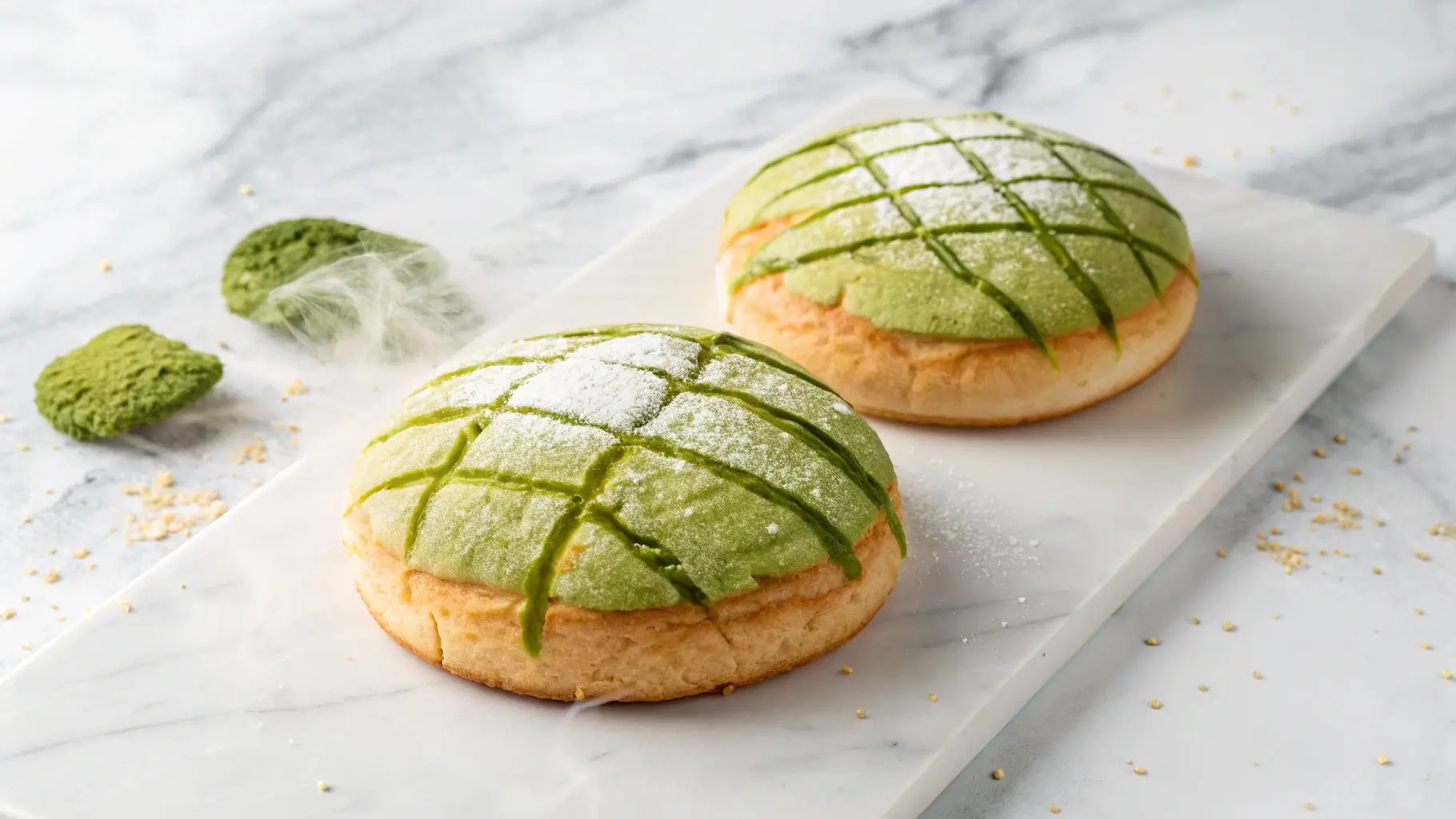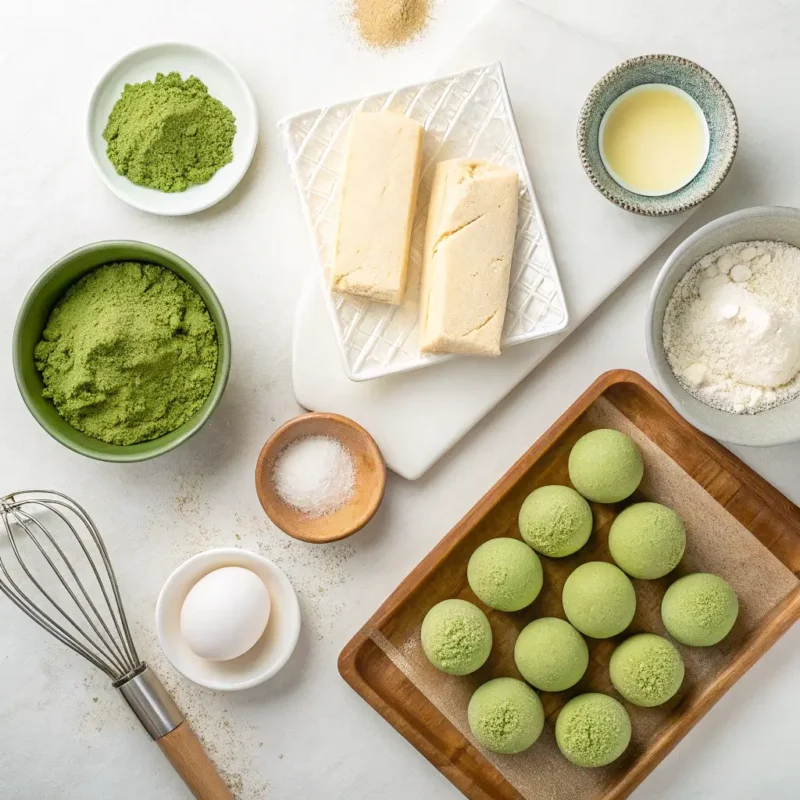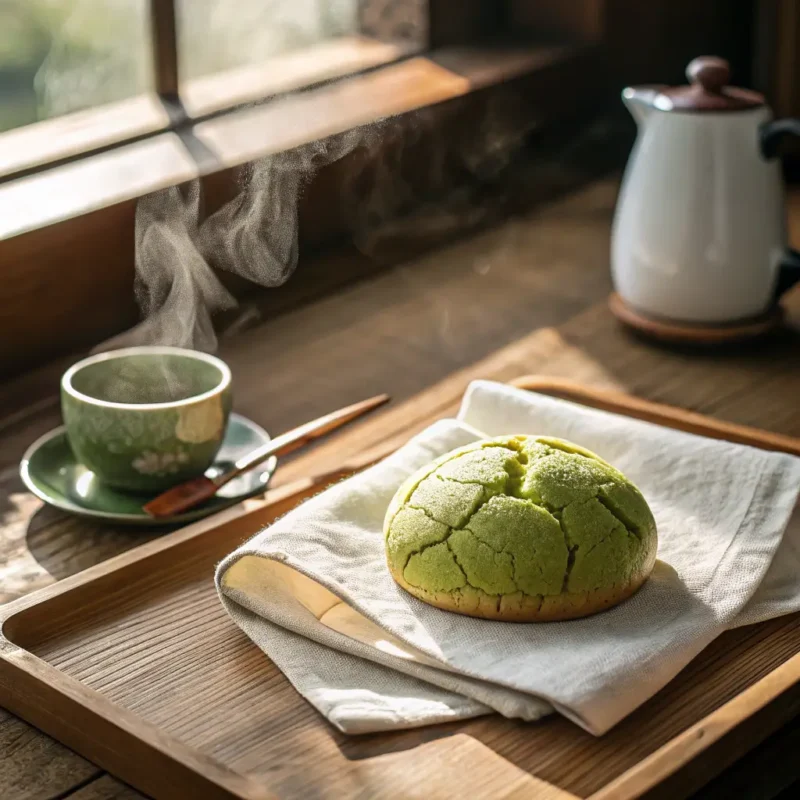Few pastries capture the magic of Japanese baking quite like matcha melon pan. This vibrant green treat combines a crisp cookie crust with fluffy matcha-infused bread, creating a textural masterpiece that’s as delicious as it is photogenic. Whether you’re new to Japanese sweets or a seasoned matcha enthusiast, this comprehensive guide will walk you through everything from its fascinating origins to step-by-step baking instructions.
What Makes Matcha Melon Pan Special?
At first glance, you might mistake matcha melon pan for a simple sweet bun. But bite through its signature crackled top, and you’ll discover why this pastry has become a global sensation:
- Unique texture contrast: The crisp sugar cookie exterior gives way to pillowy-soft bread inside
- Elegant flavor balance: Earthy matcha green tea perfectly complements the sweet cookie shell
- Eye-catching appearance: Its vibrant green hue and distinctive grid pattern make it Instagram gold
- Cultural fusion: A modern twist on Japan’s classic melon pan (which contains no actual melon)
The name “melon pan” comes from the traditional crosshatch pattern that resembles a melon’s rind. When bakers started incorporating premium matcha powder into both the bread and cookie topping, they created something truly extraordinary.
A Brief History of Melon Pan’s Evolution
Melon pan first appeared in Japanese bakeries during the early 20th century, likely inspired by European pastries but adapted to local tastes. The original version featured:
- A simple sweet bun base
- A crisp sugar cookie topping
- The iconic melon-patterned crust
The matcha variation emerged more recently as Japan’s tea culture collided with modern baking trends. Kyoto’s famous tea-producing region, Uji, helped popularize matcha desserts, leading to innovations like matcha melon pan. Today, you’ll find it everywhere from convenience stores to high-end patisseries.
The Science Behind the Perfect Matcha Melon Pan
Creating authentic matcha melon pan requires understanding how ingredients interact:
1. Matcha Quality Matters
- Ceremonial-grade matcha (bright green, smooth flavor) works best
- Culinary-grade matcha can taste bitter in baked goods
- The powder should smell fresh and grassy, not stale
2. Flour Selection
- Bread flour (higher protein) creates chewy, structured bread
- All-purpose flour makes the tender cookie topping
3. The Yeast Factor
- Active dry yeast needs proper activation (110°F water)
- Instant yeast can be mixed directly with dry ingredients
4. Temperature Control
- Cookie dough must chill to prevent spreading
- Final proofing should occur in a warm, humid environment
Step-by-Step Matcha Melon Pan Recipe
Ingredients (makes 8 buns):
For the bread dough:
- 250g bread flour
- 15g milk powder
- 30g sugar
- 3g salt
- 4g instant yeast
- 1 large egg
- 120ml warm water
- 20g unsalted butter
- 10g matcha powder
For the cookie topping:
- 100g all-purpose flour
- 60g sugar
- 50g unsalted butter
- 1 egg yolk
- 5g matcha powder
Instructions:
1. Make the Bread Dough
- Whisk dry ingredients (flour, matcha, sugar, salt, yeast)
- Add egg and warm water, mix until shaggy dough forms
- Knead for 10 minutes until smooth and elastic
- Incorporate softened butter, knead 5 more minutes
- Let rise in greased bowl for 1 hour (until doubled)
2. Prepare Cookie Topping
- Cream butter and sugar until light
- Mix in egg yolk, then sifted flour and matcha
- Divide into 8 balls, flatten into discs, and chill
3. Assembly & Baking
- Punch down dough, divide into 8 portions
- Shape into smooth balls, place on baking sheet
- Cover each with chilled cookie disc
- Use a knife to create the melon pattern
- Proof 30 minutes until puffy
- Bake at 350°F (180°C) for 15-18 minutes
Pro Tips for Success:
- Chill cookie dough for easier handling
- Don’t skip the second proofing
- Brush tops with milk for extra shine
- Cool completely before eating for perfect texture
Where to Find Authentic Matcha Melon Pan
While homemade is rewarding, these spots serve exceptional versions:
In Japan:
- Kimuraya (Tokyo): One of Japan’s oldest bakeries
- Gion Tsujiri (Kyoto): Matcha specialists
International:
- Tous Les Jours (USA/Korea): Korean chain with Japanese influences
- Bread Papa’s (Worldwide): Famous for cream puffs but makes great melon pan
Online Options:
- Japan Crate (subscription boxes)
- Yamibuy (Asian grocery delivery)
Creative Variations to Try
Take your matcha melon pan to the next level with these twists:
1. Stuffed Versions
- Sweet red bean paste (anko)
- White chocolate ganache
- Custard cream
2. Flavor Combinations
- Matcha-black sesame swirl
- Yuzu-matcha fusion
- Chocolate-dipped edges
3. Dietary Adaptations
- Vegan: Coconut oil instead of butter, flax eggs
- Gluten-free: 1:1 gluten-free flour blend
- Lower sugar: Erythritol substitution
Why Matcha Melon Pan Deserves the Hype
Beyond being delicious, this pastry offers:
Health Benefits
- Matcha provides antioxidants like EGCG
- Contains L-theanine for calm focus
- Lower sugar than many Western pastries
Cultural Significance
- Represents Japan’s innovation in baking
- Bridges traditional tea culture with modern desserts
Universal Appeal
- Satisfies sweet cravings without being cloying
- Equally good with coffee or green tea
- Fun to make and beautiful to present
Frequently Asked Questions
FAQs About Melon Pan
Why is it called melonpan?
It’s called “melonpan” because the cracked cookie topping resembles the texture of a melon’s skin, even though it doesn’t contain actual melon.
What does a melon pan taste like?
Melon pan tastes sweet and slightly buttery, with a crunchy cookie crust and soft, fluffy bread inside.
Is melon pan healthy?
While not overly healthy due to its sugar content, melon pan can be enjoyed in moderation as an occasional treat.
What is inside a melon pan?
Traditionally, melon pan has no filling, but variations may include custard, red bean paste, or chocolate for added flavor.
What is the flavor of the melon pan?
The flavor of melon pan is primarily sweet, with hints of vanilla or caramel from the cookie topping complementing the soft bread.
What is the difference between concha and melon pan?
Concha is a Mexican sweet bread with a softer, sweeter topping, while melon pan is Japanese and features a crunchier, cookie-like crust.
Conclusion and Final Thoughts
Matcha melon pan represents the perfect marriage of Japanese baking tradition and contemporary flavors. Whether you visit a specialty bakery or embark on the rewarding journey of making it yourself, each bite offers a delightful contrast of textures and a sophisticated balance of sweetness and earthiness.
For baking enthusiasts, mastering this recipe opens doors to exploring Japan’s rich pastry culture. For food lovers, it’s simply one of the most enjoyable ways to experience premium matcha. Whichever camp you’re in, one thing’s certain—once you try proper matcha melon pan, you’ll understand why it’s become a global phenomenon.
Ready to bake? Grab some quality matcha and share your creations with #MatchaMelonPanMagic!




2 thoughts on ““Matcha Melon Pan: The Complete Guide to Japan’s Beloved Green Tea Pastry””